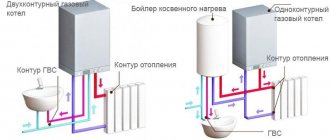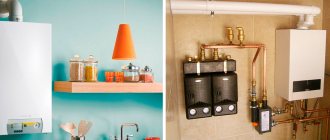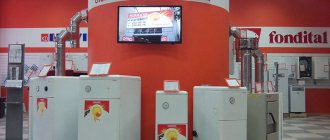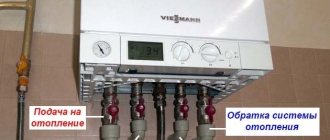Are you choosing a gas boiler to install an autonomous heating system in a private house or apartment? Agree, I want to choose the best equipment that can provide you and your family with hot water and heat during the cold season. But you just can’t decide what is better to buy - a double-circuit or single-circuit gas boiler?
We will help you understand this issue - the article discusses the features of double-circuit and single-circuit equipment, their main advantages and disadvantages, and the subtleties of using each of them. A comparison of two types of boilers was also made, thematic photos and video recommendations were selected for choosing the best option, based on the individual needs of a potential buyer.
Design and operating features of boilers
Modern gas boilers, depending on the number of circuits, can be single-circuit or double-circuit. They are externally and structurally similar, but are designed to solve different problems, and under different conditions.
As a result, it can be argued that both types of equipment are equally useful and effective, so there is no better one among them. So it all depends on the right choice. Next, we will look in detail at how the single-circuit type of gas boiler differs from its double-circuit counterpart.
Differences in the design of single- and double-circuit units
Products that belong to both types of equipment mostly consist of the same components.
The detailed design of a modern single-circuit wall-mounted boiler and the design diagram of its double-circuit “brother” are shown in the following figures:
Any single-circuit boiler is characterized by structural simplicity. Which makes them more reliable and affordable. But the listed advantages are offset by the need to buy a boiler
The presence of a complex heat exchanger and a three-way valve in a double-circuit unit makes it fundamentally different from any single-circuit analogue
The main components of the two types of boilers are similar - both the name and the purpose.
Thus, similar elements of single- and double-circuit equipment:
- cold water supply pipelines;
- gas-burner;
- membrane tank;
- chimney.
Even the structural element intended for heating water is called the same - a heat exchanger.
But, if you look at it, it turns out: the name is the only thing that makes the specified unit similar in different types of boilers - the heat exchanger of a single-circuit unit is a pipe that serves to effectively transfer the heat released during gas combustion to water.
An important difference between double-circuit boilers is that they are equipped with everything necessary for heating rooms and hot water supply. Therefore, there will be no additional costs for the purchase of equipment, and they also allow you to save space
But in the case of its double-circuit analogue, everything is not so simple, since its heat exchanger is structurally more complex. Moreover, such products are divided into separate subtypes and are bithermal and double .
In the first case, the structure is a pipe placed in a similar product of a larger diameter. This feature allows you to create 2 circuits , one of which is designed to transfer heat to the liquid used for heating, and the second for the hot water supply system.
The double heat exchanger consists of:
- pipes that provide heating of water for heating;
- plates that transfer heat to the liquid for water supply.
That is, the heat exchangers of double-circuit boilers differ in design complexity solely because of the need to solve 2 problems.
But still, the most significant difference between single-circuit and double-circuit products is the presence of a three-way valve . The purpose of which is to change the direction of hot water.
So in the standard position the valve is in a position in which the coolant is supplied only to the radiators. Everything changes when the hot water tap opens. Since the three-way valve, having received the corresponding signal, moves to another position. Namely, in the supply of hot water.
In this case, the supply of coolant to the radiators is stopped, and in full - the premises will not be heated throughout the entire time the hot water is used for domestic purposes.
That is, the design of a double-circuit boiler allows it to supply hot water only in one of two modes. But still, such a feature should not be considered a weak point of the equipment.
Comparative review of gas boilers
Both types of equipment presented are used to heat the coolant to heat rooms and buildings. And this is where the functionality of single-circuit boilers is limited.
A single-circuit gas boiler serves exclusively to heat the coolant entering the radiators of the heating system. But if you add an indirect heating boiler to it, then it, like its double-circuit analogue, will be able to provide hot water supply
Their double-circuit analogues are additionally used to provide hot water supply to solve any household problems. That is, they make it possible to take a shower, perform any other hygiene procedures, wash dishes, etc.
Next, we will conduct a comparative review of single- and double-circuit boilers according to a number of criteria.
| Comparison criteria | Single-circuit boiler | Double-circuit boiler |
| type of instalation | floor; wall | floor; wall |
| Additional investments | absent if there is no need for domestic hot water; if DHW is required, then you need to purchase a storage boiler | absent if there are no more than 2 sampling points and they are located next to the boiler |
| Economical | turns on when the water temperature in the boiler cools below the permissible level | the heating circuit turns on when the coolant cools below the permissible level; The DHW circuit turns on every time after water withdrawal starts |
| Compactness | when used in conjunction with a boiler, the space required actually doubles | more compact than single-circuit ones; wall-mounted models are suitable for use in limited spaces |
| Ease of use | when used in conjunction with a boiler, hot water will be the same temperature at all points of selection; The coolant is supplied evenly to the heating system | when the boiler power is insufficient and there are many water intake points, changes in the temperature of the water and coolant are possible, and sudden ones; When the taps are open, water is not supplied to the heating system |
As you can see, to organize hot water supply in the presence of a single-circuit boiler, you will have to buy additional equipment. For example, an indirect heating boiler. And these are additional expenses.
Moreover, after purchasing a boiler, it must be installed and connected correctly. We described in detail how to do this correctly and what to consider when operating such devices in this article.
Briefly about the main thing
In order to understand what is better - a single-circuit or double-circuit gas boiler, you must first find out how they are designed and what their pros and cons are.
The unit on the 1st circuit includes the following main components:
- Heat exchanger.
- Burner.
- Ignition system.
- Automation.
The 2-circuit analogue, in addition to this basic set, is equipped with a small heat exchanger for domestic hot water, a 3-way mechanism, a membrane tank, a safety group and a pump. In this case, a 1-circuit boiler initially works only for heating. In order to receive hot water from it, you need to connect an indirect heating boiler. 2-circuit models operate for both heating and hot water production.
However, when water is drawn, the supply of coolant to the radiators stops. In addition, both modifications have their own specific pros and cons. At the same time, the main differences between them are observed in hot water supply, dimensions, power and area of the room, equipment and space occupied by the equipment.
Advantages and disadvantages of equipment
Both types of gas boilers are easy to operate, efficient and durable. They also have an attractive appearance.
The design of each type of gas boiler is designed to meet the needs of different categories of users, which clearly demonstrates their advantages and disadvantages. They also provide an opportunity to understand the differences between a single-circuit gas boiler and its double-circuit counterpart, helping the potential buyer make the right choice.
Pros and cons of single-circuit units
Such products are capable of providing stable heating of rooms of any size, number of floors, and distance from the heat exchanger.
And, in addition, single-circuit boilers:
- more reliable than their double-circuit counterparts, the design of which is more complex, which leads to a slightly larger number of breakdowns;
- easier to maintain , which is also caused by design features;
- cheaper.
An important advantage is that single-circuit units can become a base for connecting other equipment . This will expand their functionality and increase the comfort of living.
You should always remember that if you need to provide hot water supply in the premises, you will have to buy a storage boiler together with a single-circuit boiler. And this will lead to considerable additional costs. And a set of the listed equipment will take up a lot of space, which can be critical for small apartments
Connecting storage boilers will provide the premises with hot water supply. Moreover, the water will be supplied hot at any time, which is not always possible to achieve from dual-circuit analogues
This type of equipment, in the absence of the need for hot water supply, has no pronounced shortcomings. But otherwise, the lack of universality immediately affects. Which leads to the need to purchase an additional electric heating device.
As a result, its joint operation with a single-circuit boiler leads to:
- high costs for purchase, installation, maintenance;
- limited volume of water for domestic needs - boilers are most often purchased for joint use with single-circuit units, so the question may arise about the rational consumption of water, the volume of which depends on the capacity of the storage tank;
- greater load on the wiring.
The last drawback is relevant in cases where the house or apartment has old wiring or powerful electrical equipment is used in parallel. So, it may be necessary to modernize the electrical wiring and select a cable with a larger cross-section.
You should also be aware that a set of a single-circuit boiler and boiler takes up significantly more space than one double-circuit boiler. And with limited space this can be a significant disadvantage.
Advantages and disadvantages of double-circuit boilers
Units that belong to the specified type have some restrictions, but are still capable of providing hot water to two systems at once (heating, hot water supply). They also take up less space than their boiler counterparts. As a result, double-circuit boilers are more convenient to use.
Both types of gas boilers are easy to operate, efficient and durable. They also have an attractive appearance.
In addition, the competitive struggle of manufacturers has led to the fact that the difference in the cost of both types of units is gradually leveled out.
Therefore, today you can find a double-circuit boiler whose price is slightly higher than that of a single-circuit product. Which in some cases can also be considered an advantage.
If we talk about the disadvantages of double-circuit boilers, the most important is the inability to instantly provide hot water of the same temperature to all water consumption points in a house or apartment.
So, in their heat exchangers the amount of water that is needed right now is heated. That is, no stock is created. As a result, the water temperature may differ from what you expect or may change as you use it. This happens when the pressure or pressure changes, for example, after opening/closing the second tap.
When using a double-circuit boiler, the water temperature often differs at two different water intake points - hot water can be delivered to the desired point with a significant delay. Which is inconvenient and leads to additional costs
As for installation, installation of double-circuit boilers is a more complex procedure, especially at the design stage. Since you will have to follow numerous manufacturer’s recommendations
Rating of the best models
Non-volatile boilers are produced by many companies. From the Russian ones they single out. It supplies devices of various modifications.
The unit with the optimal price-quality ratio is the Lemax Classic-12.5 V floor-standing gas boiler. Its power is 12.5 kW. The indicator is enough to heat a large house with an area of 125 sq.m. The boiler is lightweight and small in size, so it is not difficult to find a suitable place for it. The device is equipped with a cast steel heat exchanger and has no seams, which allows for the highest possible strength for this material.
The products of the Slovak brand are popular. The Protherm Bear 20 TLO boiler is considered effective. Such a device is heavy because its heat exchanger is made of cast iron. The advantages of the model are high efficiency (at 90%), power 18 kW. In practice, the unit can provide heating for a room with an area of up to 240 sq.m (if the house is built from materials with low heat loss).
The products of the Italian brand Baxi have proven themselves. The SLIM EF 1.22 model is popular, characterized by high power (22 kW), which is enough to heat a house with an area of 230-240 sq.m. Its efficiency is lower than that of the described models - 88%. The device is equipped with automatic devices that provide a high level of safety during operation, and has an attractive design: not every company cares about this aspect when producing products.
The Italian brand Beretta also offers energy-independent gas boilers. The main advantage is the presence of a cast heat exchanger made of cast iron alloy, which makes the device strong and durable. Characterized by smooth ignition and silent operation, which is important if the boiler is installed in a room where people are constantly present. With a power of 18 kW, the device provides a large heating area. Gas consumption is relatively low, while the efficiency is 93%.
Despite the fact that the listed models are distinguished by their quality and well-thought-out design, they have the disadvantages of non-volatile boilers, as well as the relatively rapid failure of the thermocouple - after 10-12 years from the start of operation. It is not difficult to purchase a spare one, but it is better to install the part at a service center rather than yourself.
Which boiler is better to choose?
When choosing the best boiler, you should keep in mind that each type of equipment is designed for specific conditions. If followed, they will show maximum efficiency, allow you to achieve the expected result and mitigate shortcomings.
Therefore, it is so important to determine your requirements and take into account living conditions. So, if the equipment is selected for the apartment and there is no extra space for installation, then a double-circuit wall-mounted boiler would be the ideal option. And although it is inferior in power to floor-standing models, it is quite capable of meeting the needs of residents.
For a dacha or a private house where there is a separate room for a boiler room, an excellent solution would be to install a floor-standing single-circuit gas boiler in conjunction with a boiler of the required volume. This will ensure that the family needs hot water and heat.
When installing any model of a floor-standing single-circuit boiler with a boiler, an order of magnitude more space will be required than for double-circuit analogues. And the load on the equipment in this case will be higher, so it is important to correctly select the required boiler power
If you are selecting a heating unit for a country two-story house or cottage, then in this situation it is best to opt for a powerful double-circuit floor-standing boiler with a built-in large-volume heater.
Floor-standing gas boilers with one and two circuits differ in greater power from their wall-mounted “brothers”. They are also most often non-volatile . This is quite convenient, especially if there are power outages in the region.
We provided more recommendations and important criteria for choosing gas boilers in the next article.
Insertion of AOGV into heating
Since it is not difficult to include AGV in home heating, you can do it yourself, but you will first need permission from the utility services. The insert involves connecting the unit to the heating pipes, as well as to the gas main. To prevent scale particles and dirt from getting inside the boiler, coarse filters must be installed on the inlet pipes. All threaded connections are sealed using tow and O-rings.
Shut-off valves are installed on water pipes. Only a person who has permission to do this type of work can connect the boiler to the main gas line. The gas pipe is also connected with additional sealing. When connecting, copper products or corrugated hoses are used.
Rubber parts are not used because over time they crack and can leak gas, which, if accumulated in the room, will lead to disastrous consequences. A union nut is used to secure the corrugated hose.
Conclusions and useful video on the topic
This video will help you understand the features of different types of gas boilers:
The video material is intended to deepen your knowledge on the topic and help you make the right choice:
When choosing between a double-circuit boiler and its single-circuit counterpart, you should not wonder which is better. Since all of the above equipment is modern, productive and durable, but, as mentioned above, it is designed to solve different problems. Therefore, it is so important to take into account personal needs and living conditions so that the equipment does not disappoint you.
How many circuits does your gas boiler have? Share your impressions of using your heating equipment - tell us whether the selected boiler satisfies all your needs or for some reason you consider your choice to be wrong? Add a photo of your gas boiler, indicate its pros and cons discovered during operation.
Types of dual-circuit heaters
As noted above, such units can have one or two heat exchangers. The first option is much more compact, but it has much lower performance. The thermal energy generated during fuel combustion is spent both for heating needs and for hot water supply. As a result, productivity here is often quite low.
The heat exchanger itself in such models is bithermal or plate:
- The bithermic configuration is a special cellular system with isolated channels. This option is compact and has high efficiency. However, due to the temperature difference in the circuits, stresses arise in the metal structure and salts contained in the water accumulate more actively. Therefore, if you have fairly hard water in your pipes, then such a heat exchanger will not suit you.
- Plate options are a system of insulated pipes that are interconnected by metal plates. In such a heat exchanger, salts accumulate less, but it is larger and less productive.
Models with two heat exchangers are more efficient, since heating water for heating and taps occurs separately. Moreover, a number of models also have two gas burners, thanks to which the circuits operate completely independently. This provides increased performance in both operating modes. However, such boilers are significantly more expensive, they are more difficult to install and maintain.
Do I need to reduce power?
In modern models of gas boilers equipped with highly sensitive automation, there is no need to independently reduce power indicators. In equipment of earlier production and the simplest units, similar measures are carried out:
- in case of alteration of the heating system with a significant decrease in the level of overall performance;
- in case of refusal of certain additional functionality, including dismantling the hot water supply system and “warm floors”.
If there are significant differences in the received and minimum power indicators, the equipment “clocks”, accompanied by constant turning on and off of the boiler. In this case, accelerated wear of working components such as the burner, three-way valve and pumping device is observed. In order to prevent boiler failure, it is necessary to reduce the power indicators in one of the available ways:
- replacement of the burner device with a modulating analogue;
- reducing fuel supply by changing valve settings;
- reducing power through service menu settings;
- regulating the functioning of the circulation pump.
In order to reduce fuel consumption, a thermostat is installed to ensure more accurate operation of the equipment, and weather-dependent automation devices are installed. A necessary condition for maintaining the high quality of operation of a gas boiler is proper maintenance of the unit, as well as increasing thermal efficiency by insulating the premises.
Prices
Not only functionality and design features, but also cost, directly depend on the purpose, power and model of the condensing boiler. All single-circuit models are used exclusively for heating, and double-circuit designs also allow for water heating.
- wall-mounted gas condensing models Protherm “Lynx” – costing from 35 thousand rubles;
- wall-mounted gas condensing boilers BAXI - costing from 48 thousand rubles;
- wall-mounted gas condensing models Ariston – costing from 60 thousand rubles;
- wall-mounted gas condensing boilers VAILLANT – costing from 58 thousand rubles.
It should be noted that today the line of gas condensing equipment is produced by most manufacturers, and can be represented by premium, middle class or economy class models.
The first option is represented, as a rule, by German brands, and is distinguished by ease and safety of operation, stylish design, silent operation and compliance with all European environmental standards.
Demonstrating the benefits of condensing boilers
The mid-price category includes models produced under the BAXI brand. Such designs are comfortable, economical and environmentally friendly, and can be single- or double-circuit, wall-mounted or floor-mounted. Economy class is represented by Korean and Slovak manufacturers.
Such models, adapted for use in Russian conditions, are distinguished by simple functionality and a minimum number of complex options.
The main advantages of economy class equipment include adaptability to pressure drops and frequent failures in the electrical supply system.











